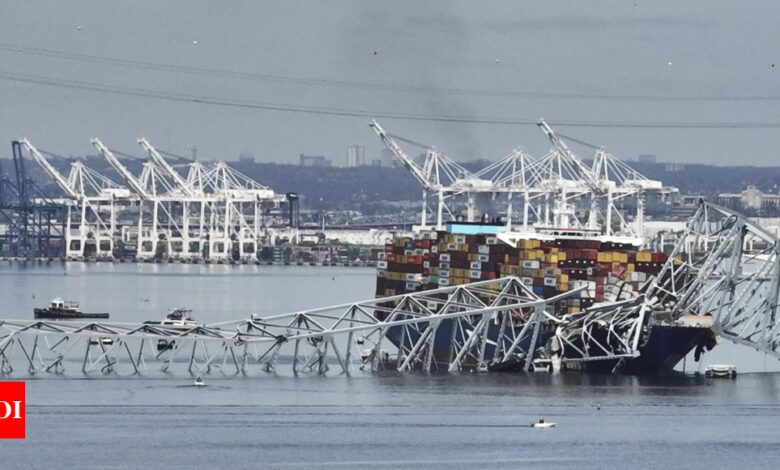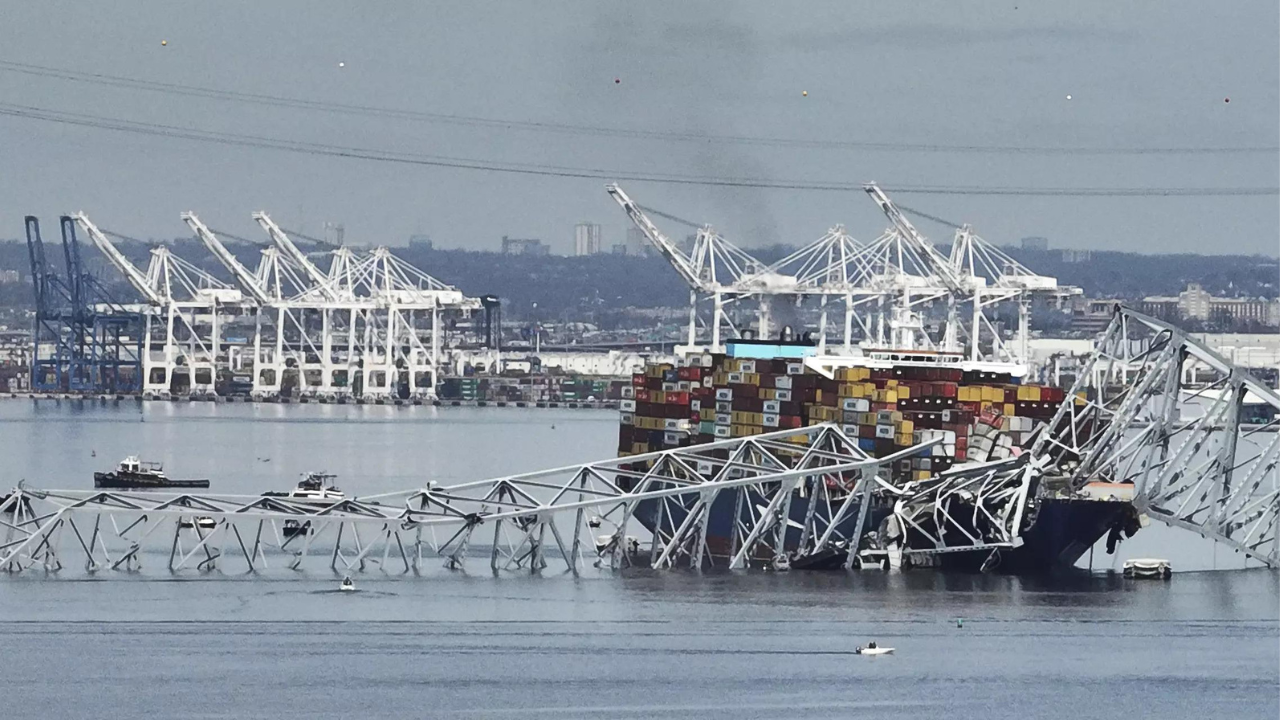World
Will bridge collapse hurt global supply chains?

[ad_1]
In the early hours of March 26, the Singapore-flagged ship Dali, loaded with 5,000 containers, slammed into Baltimore’s Francis Scott Key Bridge, causing the 1.6-mile (2.5-kilometer) bridge to collapse in a matter of seconds. The Dali was departing for Colombo when the disaster struck. Initial fears were confirmed that half a dozen people lost their lives in the accident.
Baltimore’s port had to be shut down, leaving millions of tons of coal, hundreds of cars, and deliveries of lumber and gypsum stranded.About 40 ships were ready to depart on Tuesday, and a big number of ships coming from the Atlantic cannot dock “until further notice,” as the port’s authorities said.
Financial markets reacted quickly to the bridge collapse, with shares of global shipping line Maersk plummeting 2.6% in Copenhagen on Wednesday.
But, an analyst from online broker Nordnet told the news agency Reuters, in the long run, “this event is not a major catalyst for stock prices, unless something unpleasant comes up, like indications of gross negligence behind the accident.”
Gregory Daco, the chief economist at EY, also remains calm. “I think the macroeconomic effects will remain limited,” he told Bloomberg News on Wednesday.
‘Path to normalcy’
US Transportation Secretary Pete Buttigieg warned of a “major and protracted impact to supply chains” following the closure of the Port of Baltimore. “It’s too soon to offer estimates on what it will take to clear the channel and reopen the port,” he told reporters during a briefing in Baltimore on Tuesday.
Buttigieg referred to the bridge as one of the “cathedrals of American infrastructure,” stressing that rebuilding it will take time. “The path to normalcy will not be easy,” he said. “It will not be quick, it will not be inexpensive, but we will rebuild together.”
US President Joe Biden called the collapse a “terrible accident,” and pledged to get the port reopened and the bridge rebuilt. “I intend for the federal government to cover the entire cost of rebuilding this bridge,” Biden said in Washington.
Costs for rebuilding the bridge are estimated at $500 million to $1.2 billion (€462 million-€1.1 billion), with at least two years of construction time.
The Port of Baltimore is particularly important for importing and exporting automobiles and light trucks. Approximately 850,000 vehicles are shipped there annually, supporting around 15,000 jobs. Additionally, the Francis Scott Key Bridge is a crucial artery on the East Coast, with approximately 30,000 vehicles crossing the bridge every day.
Supply-chain worries reloaded?
European automakers, including Mercedes, Volkswagen and BMW, maintain extensive infrastructure in the Baltimore region for vehicle shipment.
A spokesperson for the German premium carmaker BMW said in an email to Reuters that the company does not expect any immediate impact other than short-term traffic delays. The company uses the Port of Baltimore to import vehicles, but the automotive terminal is located at the harbor entrance, in front of the bridge, and can still be accessed, the spokesman added.
US car giant Ford, however, will have to “divert parts to other ports,” which will impact its supply chain. Ford CFO John Lawler told Reuters in a statement that “where workarounds are necessary in the short term, our team has already secured shipping alternatives.”
Ryan Peterson, founder and CEO of logistics platform Flexport, said that, with Baltimore handling only 1.1 million containers in 2023, any impact on container rates and shipping costs from the disruption would be far less than increases caused by cargoes diverted as a result of the attacks by the Houthi militant group in the Red Sea.
“East Coast volumes are down and there is the ability for those ports to flex up to handle this,” he told Bloomberg. He warned, however, of “traffic jams and delays” as a sudden increase in traffic at a port by 10% to 20% would be enough to cause all sorts of delays.
Ports in Germany
Ulf Kaspera, from the Federal Bureau of Maritime Casualty Investigation in Hamburg, sees no imminent danger of a similar accident happening in Germany.
“The specific safety measures to be taken depend on the port operators,” he told DW, noting that in Hamburg, for example, it is mandatory for large ships to be towed and maneuvered in wide areas of the port. The use of tugboats can “prevent such accidents,” he said.
Josef Hegger, from the Institute of Structural Concrete at RWTH Aachen University, said the accident in Baltimore could have been prevented. The university lecturer is an expert in bridge construction, and told German news agency dpa that a combination of various structural measures can achieve the highest level of safety.
“The pillar must have a certain resilience so that it does not collapse at the slightest impact,” he said.
Germany’s Federal Waterways Engineering and Research Institute has established strict rules regarding the forces that bridge pillars must be able to withstand upon impact. In addition, so-called guardrails on bridges are meant to prevent collisions with the pillars.
“On the Rhine bridges, the large pillars and pylons are often located at the edge of the river so that the river opening is completely free,” Hegger said. “If there is a pillar in the middle, it is relatively massive and wedge-shaped and would deflect a ship that hits it.”
Hegger said ships were more likely to run aground there “before hitting the pillar with full force.”
Baltimore’s port had to be shut down, leaving millions of tons of coal, hundreds of cars, and deliveries of lumber and gypsum stranded.About 40 ships were ready to depart on Tuesday, and a big number of ships coming from the Atlantic cannot dock “until further notice,” as the port’s authorities said.
Financial markets reacted quickly to the bridge collapse, with shares of global shipping line Maersk plummeting 2.6% in Copenhagen on Wednesday.
But, an analyst from online broker Nordnet told the news agency Reuters, in the long run, “this event is not a major catalyst for stock prices, unless something unpleasant comes up, like indications of gross negligence behind the accident.”
Gregory Daco, the chief economist at EY, also remains calm. “I think the macroeconomic effects will remain limited,” he told Bloomberg News on Wednesday.
‘Path to normalcy’
US Transportation Secretary Pete Buttigieg warned of a “major and protracted impact to supply chains” following the closure of the Port of Baltimore. “It’s too soon to offer estimates on what it will take to clear the channel and reopen the port,” he told reporters during a briefing in Baltimore on Tuesday.
Buttigieg referred to the bridge as one of the “cathedrals of American infrastructure,” stressing that rebuilding it will take time. “The path to normalcy will not be easy,” he said. “It will not be quick, it will not be inexpensive, but we will rebuild together.”
US President Joe Biden called the collapse a “terrible accident,” and pledged to get the port reopened and the bridge rebuilt. “I intend for the federal government to cover the entire cost of rebuilding this bridge,” Biden said in Washington.
Costs for rebuilding the bridge are estimated at $500 million to $1.2 billion (€462 million-€1.1 billion), with at least two years of construction time.
The Port of Baltimore is particularly important for importing and exporting automobiles and light trucks. Approximately 850,000 vehicles are shipped there annually, supporting around 15,000 jobs. Additionally, the Francis Scott Key Bridge is a crucial artery on the East Coast, with approximately 30,000 vehicles crossing the bridge every day.
Supply-chain worries reloaded?
European automakers, including Mercedes, Volkswagen and BMW, maintain extensive infrastructure in the Baltimore region for vehicle shipment.
A spokesperson for the German premium carmaker BMW said in an email to Reuters that the company does not expect any immediate impact other than short-term traffic delays. The company uses the Port of Baltimore to import vehicles, but the automotive terminal is located at the harbor entrance, in front of the bridge, and can still be accessed, the spokesman added.
US car giant Ford, however, will have to “divert parts to other ports,” which will impact its supply chain. Ford CFO John Lawler told Reuters in a statement that “where workarounds are necessary in the short term, our team has already secured shipping alternatives.”
Ryan Peterson, founder and CEO of logistics platform Flexport, said that, with Baltimore handling only 1.1 million containers in 2023, any impact on container rates and shipping costs from the disruption would be far less than increases caused by cargoes diverted as a result of the attacks by the Houthi militant group in the Red Sea.
“East Coast volumes are down and there is the ability for those ports to flex up to handle this,” he told Bloomberg. He warned, however, of “traffic jams and delays” as a sudden increase in traffic at a port by 10% to 20% would be enough to cause all sorts of delays.
Ports in Germany
Ulf Kaspera, from the Federal Bureau of Maritime Casualty Investigation in Hamburg, sees no imminent danger of a similar accident happening in Germany.
“The specific safety measures to be taken depend on the port operators,” he told DW, noting that in Hamburg, for example, it is mandatory for large ships to be towed and maneuvered in wide areas of the port. The use of tugboats can “prevent such accidents,” he said.
Josef Hegger, from the Institute of Structural Concrete at RWTH Aachen University, said the accident in Baltimore could have been prevented. The university lecturer is an expert in bridge construction, and told German news agency dpa that a combination of various structural measures can achieve the highest level of safety.
“The pillar must have a certain resilience so that it does not collapse at the slightest impact,” he said.
Germany’s Federal Waterways Engineering and Research Institute has established strict rules regarding the forces that bridge pillars must be able to withstand upon impact. In addition, so-called guardrails on bridges are meant to prevent collisions with the pillars.
“On the Rhine bridges, the large pillars and pylons are often located at the edge of the river so that the river opening is completely free,” Hegger said. “If there is a pillar in the middle, it is relatively massive and wedge-shaped and would deflect a ship that hits it.”
Hegger said ships were more likely to run aground there “before hitting the pillar with full force.”
#bridge #collapse #hurt #global #supply #chains






